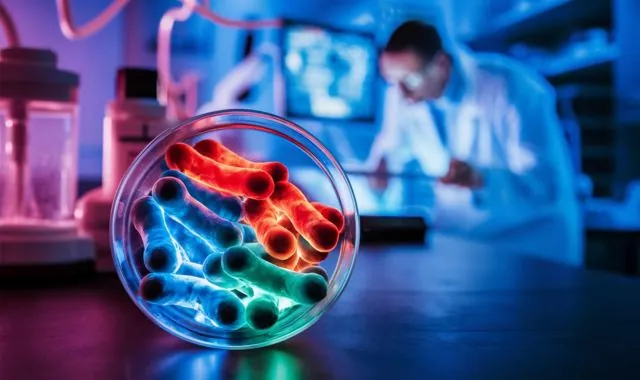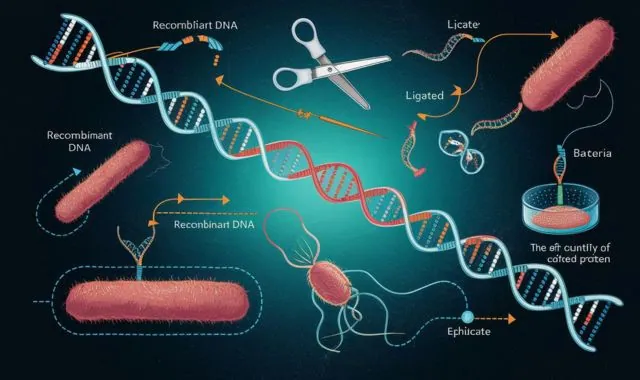Physical Address
304 North Cardinal St.
Dorchester Center, MA 02124

Recombinant DNA technology lets scientists combine DNA from different organisms. This allows for creating new traits in plants, producing life-saving medicines, and developing biofuels. It’s a powerful tool with ethical considerations, but holds immense promise for the future of medicine, agriculture, and industry.

Have you ever wondered how scientists can take a gene from a fish and introduce it into a plant? Or how medicine can now be tailored to an individual’s specific needs? The answer lies in a remarkable field called recombinant DNA technology. This article will be your guide, delving into the fascinating world of manipulating DNA to create positive change.
Recombinant DNA technology, often referred to as genetic engineering, is the process of combining DNA from different sources. This allows scientists to create new genetic combinations that wouldn’t exist naturally. It’s like taking pieces from different puzzles and building something entirely new!
This ability to merge genomes unlocks a treasure trove of possibilities. We can introduce genes for desirable traits into organisms, leading to advancements in medicine, agriculture, and even industrial processes.
But before we explore these applications, let’s take a step back. DNA is the blueprint of life, containing the instructions that build and maintain an organism. It’s a complex molecule made up of smaller units called nucleotides. The order of these nucleotides determines the specific genes and, ultimately, the traits of an organism.
Recombinant DNA technology is like following a recipe. Here’s a breakdown of the key steps:
Imagine you want to add a gene for pest resistance to a plant. First, scientists need to find and isolate that specific gene from another organism, like a bacterium known to resist pests.
This is where things get interesting. Scientists use vectors, often modified viruses or plasmids (circular DNA molecules found in bacteria), to carry the isolated gene into the host organism. Think of the vector as a tiny mail truck delivering the gene to its destination.
Now, the vector with the new gene needs to enter the host organism. This process, called transformation, can involve different techniques depending on the organism. For example, bacteria might be exposed to a calcium chloride solution to make their cell walls more permeable, allowing the vector to enter.
Not all cells will successfully take up the new DNA. Scientists employ clever methods to identify and isolate the transformed cells, ensuring they contain and express the desired gene.

Recombinant DNA technology has revolutionized many fields, bringing about significant advancements:
This technology allows scientists to produce essential proteins, like insulin for diabetics, in large quantities using bacteria or yeast. This has transformed the lives of millions who depend on these medications.
Gene therapy offers the potential to treat genetic diseases by introducing healthy copies of genes to replace defective ones. While still in its early stages, it holds immense promise for the future of medicine.
By introducing genes for pest resistance into plants, we can reduce reliance on harmful pesticides, leading to a safer food supply and a more sustainable agricultural system.
Scientists can engineer crops with higher nutritional value, like golden rice with increased beta-carotene content to combat vitamin A deficiency.

Microorganisms with enhanced capabilities to break down pollutants can be created using recombinant DNA technology, aiding in environmental cleanup efforts.
Scientists are developing genetically modified organisms to produce biofuels, offering a more sustainable alternative to fossil fuels.
With such immense power comes the responsibility to use it wisely. Here are some key considerations:
Genetically modified organisms (GMOs) created using recombinant DNA technology have sparked public debate. Concerns around potential environmental impact and unintended consequences need to be addressed through rigorous research and transparent communication.
Strict regulations and risk management protocols are essential to ensure the safe application of recombinant DNA technology. This includes thorough testing and monitoring of genetically modified organisms.
The potential of recombinant DNA technology continues to expand:
By analyzing an individual’s genetic makeup, doctors may be able to prescribe personalized treatments in the future, leading to more effective healthcare.
Technologies like CRISPR offer the ability to edit genes directly, raising both exciting possibilities and ethical dilemmas. Open discussions and responsible research are crucial as

Recombinant DNA technology offers a powerful toolbox for shaping the future. From personalized medicine to sustainable agriculture, its potential is vast. However, responsible research and open dialogue are crucial to navigate the ethical considerations that come with this revolutionary technology.